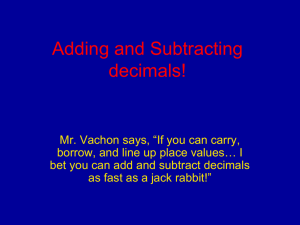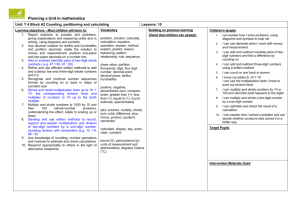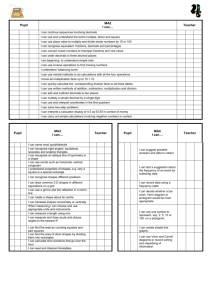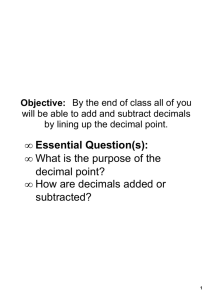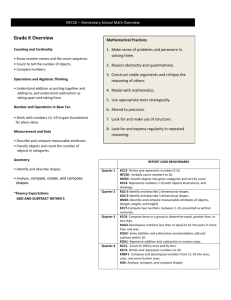6th / 6 Weeks - South Union Elementary School
advertisement
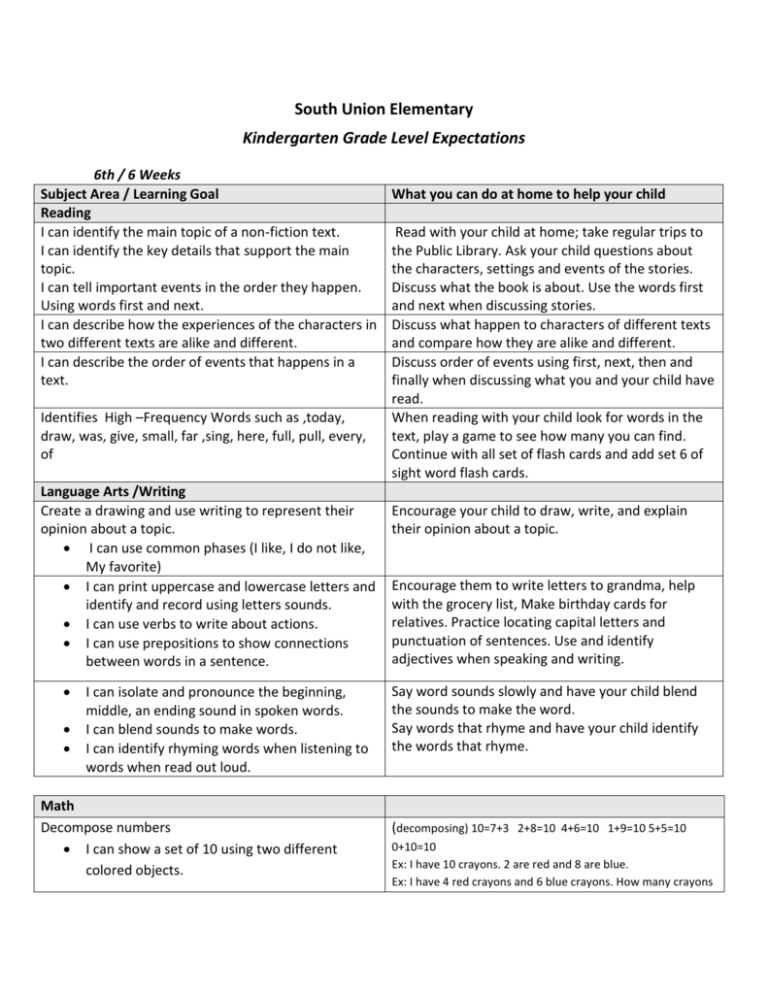
South Union Elementary Kindergarten Grade Level Expectations 6th / 6 Weeks Subject Area / Learning Goal Reading I can identify the main topic of a non-fiction text. I can identify the key details that support the main topic. I can tell important events in the order they happen. Using words first and next. I can describe how the experiences of the characters in two different texts are alike and different. I can describe the order of events that happens in a text. Identifies High –Frequency Words such as ,today, draw, was, give, small, far ,sing, here, full, pull, every, of Language Arts /Writing Create a drawing and use writing to represent their opinion about a topic. I can use common phases (I like, I do not like, My favorite) I can print uppercase and lowercase letters and identify and record using letters sounds. I can use verbs to write about actions. I can use prepositions to show connections between words in a sentence. I can isolate and pronounce the beginning, middle, an ending sound in spoken words. I can blend sounds to make words. I can identify rhyming words when listening to words when read out loud. Math Decompose numbers I can show a set of 10 using two different colored objects. What you can do at home to help your child Read with your child at home; take regular trips to the Public Library. Ask your child questions about the characters, settings and events of the stories. Discuss what the book is about. Use the words first and next when discussing stories. Discuss what happen to characters of different texts and compare how they are alike and different. Discuss order of events using first, next, then and finally when discussing what you and your child have read. When reading with your child look for words in the text, play a game to see how many you can find. Continue with all set of flash cards and add set 6 of sight word flash cards. Encourage your child to draw, write, and explain their opinion about a topic. Encourage them to write letters to grandma, help with the grocery list, Make birthday cards for relatives. Practice locating capital letters and punctuation of sentences. Use and identify adjectives when speaking and writing. Say word sounds slowly and have your child blend the sounds to make the word. Say words that rhyme and have your child identify the words that rhyme. (decomposing) 10=7+3 2+8=10 4+6=10 1+9=10 5+5=10 0+10=10 Ex: I have 10 crayons. 2 are red and 8 are blue. Ex: I have 4 red crayons and 6 blue crayons. How many crayons do I have? Operations I can fluently add and subtract combination within 5. Base Ten I can compose and decompose teen numbers 11-19 rooted to ten. Geometry I can describe the location of an object. Geometry I can name 2D shapes. I can identify and make 2D shapes. I can identify and make 3D shapes. I can tell the difference between 2D and 3D shapes. I can describe the similarities and differences between 2D and 3D shapes. I can build and draw 2D and 3D shapes. I can make bigger shapes from smaller shapes. Your child should have memorized addition and subtraction facts up to 5. All teens are composed of one group of ten and at least one one. Ex: 18 = one group of 10 and 8 ones Have your child use the describing words (above, below, beside, in front of, behind, next to) when describing the location of an object. Have your child name, identify and make the following shapes. 2D (square, circle, triangle, rectangle, hexagon) 3D (cone, sphere, cylinder, cube) Your child knows that a 2D shape is flat and a 3D shape you can see all the faces, edges and sides. Other things you can do to ensure your child’s success: A good night’s sleep – 10 hours is the recommendation for 5-6 year olds, a healthy breakfast, positive discussions about school and their accomplishments. 3/16/2016 South Union Elementary 1st Grade Level Expectations 6th/ 6 Weeks Reading I can identify the cause/effect relationship that exists between two events. I can describe characters, settings, and major events in a story, using key details. I can explain how fiction and nonfiction texts are different. I can retell stories, including key details. I can compare and contrast the adventures and experiences of characters in a story. I can recognize and read words with the –ed, -ing,-er, -est, -ly, -y and -ful endings. I can break apart two syllable words and know that each syllable must have a vowel sound. Language Arts/Writing I can develop and state an opinion on a topic and provide reasons for why I feel this way. I can create a title or introduction that provides my reader with my topic. I can create a conclusion for my writing that lets my reader know it is finished. I can recall information from own experiences to support writing. Math I can use >, <, = symbols to compare two 2 digit numbers. Read, “Cat in the Hat” and discuss what happened and why. Read “Horton Hears A Who” Have your child write or draw pictures to tell what happened in the beginning, middle, end. Check out books about animals at the library. Have at least two nonfiction and two fiction books. Read them together and have your child point out the differences. Read Goldilocks and the Three Bears. Have your child write or draw pictures to tell what happened in the beginning, middle, end. Read a few stories from the series, “Frog and Toad.” Tell about the adventures they have from each story. Look through a magazine or a newspaper. Find words with these endings and highlight them with a highlighter. While driving in the car, say some words with your child. Have them clap the syllables. Example: summer= sum/mer, happy=hap/py Have your child pick their favorite sport and provide reasons why that sport is the best sport. Have your child add a title to their opinion writing about sports. Have a child add a conclusion to their writing piece about sports. Example: Basketball is the best sport around! Make sure your child includes specific experiences about their actions and feelings related to their favorite sport. 32 ___17 Have your child explain that 32 is greater than 17. Have them say, “I know this because….” I can add a 2 digit number and a multiple of 10 within 100. 33 + 10= 43; 29 + 10= 39; 37 + 20= 57 I can explain how to find 10 more and 10 less than a given 2 digit number. I can use equations to represent a problem. 22 + 10= ___ Ask your child how they can quickly solve this problem by counting up by a group of 10. I can identify the unknown- addend in a subtraction problem. For example, subtract 10 – 5 by finding the number that makes 10 when added to 5. (If we know 5 + 5=10, then 10-5= 5) I can use strategies to solve addition and subtraction problems. I can add and subtract within 20 using helpful strategies. If you know 9+ 3= 12, then 3 + 9= 12 (“switcheroo”) I can determine the missing value in an addition or subtraction problem/equation. For example, determine the unknown number that makes the equation true in each of the equations 8 + __ = 11, 5 = ___ – 3, 6+6 =____ . I can determine where the minute hand must be when the time is to the hour and half hour. Give your child a time to the hour and/or half hour. Have them draw a clock and illustrate that time. I can compare the lengths of two objects by using a third object to compare them. Use your sock and your child’s sock. Use the remote control as a measurement tool. Then have your child measure his/her sock against the remote control. Have your child make statements such as, ―My sock is shorter than the remote control and your sock is longer than the remote control. So, my sock is shorter than your sock.‖ I can represent and organize data with up to 3 categories . 3/16/2016 Create a tally graph or bar graph of favorite color. (Ask your friends and family.) Tell your child a story problem and have them write the equation they would use to solve it. Example: Mom made 10 cookies. She ate 3. How many cookies does she have left? ( 10-3=___) Ex: adding 6 + 7 by creating the known equivalent 6 + 6 = 12 then 12+ 1 = 13 South Union Elementary 2 Grade Level Expectations nd 6th / 6 weeks Subject Area/Learning Goal Reading I can describe characters in a story. I can read two versions of the same story and locate details that are important to each version. I know and use text features: captions, bold print, and subheadings. I can identify facts and opinions the author gives me to support their point. I can recognize words quickly and make my reading sound natural. What you can do at home to help your child Read a favorite book. Draw each character. Put descriptive words around the character. Go to the library and get two different versions of The Three Little Pigs. Make a list of how they’re different and how they’re the same. Look up an article on the internet about Solids and Liquids. Print it off and highlight the dark words and headings you find. Read an article from the newspaper about a sport, or another topic of interest. Search for facts and opinions. Write your own opinion about the topic. Pick any story and read one page three times, sounding like you talk. Language Arts I can write for a variety of purposes. I can use adjectives and adverbs. I can form a contraction. I can use apostrophes to show possession. Write a poem about the spring. Pop some popcorn and write words to describe it (feel, smell, sight, taste). Write contractions on a piece of paper. Have your child write a contraction after you show them the two words. (you write will not; the child writes won’t). On a marker board, write a name of someone. Use a Cheesepuff to add the apostrophe, then write a s. Math I can fluently add within 20 using mental strategies. I can fluently subtract within 20 using mental strategies. I can fluently add 2-digit numbers using strategies. I can fluently subtract 2-digit numbers using strategies. I can solve problems within 1000 using addition and subtraction. Using flashcards, have your child respond to the problem within 3 seconds. We want them to know the answer quickly. Using flashcards, have your child respond to the problem within 3 seconds. We want them to know the answer quickly Take a deck of cards. Pick two cards. Put them together to build a number. Repeat. Then add your two numbers together. Your child has a way to add them. Let them show you. They can check their work with a calculator. Take a deck of cards. Pick two cards. Put them together to build a number. Repeat. Then subtract the smaller number from the largest number. Your child has a way to add them. Let them show you. They can check their work with a calculator. Allow your child to show you how they would solve: I saw 423 elephants and 321 monkeys at the zoo. How many animals did I see? I have 815 pieces of candy from the parade. I ate 340 pieces. How many pieces are left? South Union Elementary Third-Grade Level Expectations (GLEX) 6th/6 weeks Subject Area / Learning Goals Reading Common Core Standards I can use information the author gives me explicitly in supporting my answer to questions and drawing conclusions. I can use the characters’ actions to explain their traits, motivations or feelings. I can identify the sequence of major events in a story and describe how the characters’ actions caused the major events. What You Can Do at Home to Help Your Child Read with your child the weekly fluency assignment and have your child say or write details from the text that helps them to draw a conclusion. To draw a conclusion we us the authors clues and our own background experiences to figure out what the author doesn’t say directly. Talk with your child about what characters do in movies, books, and TV shows. Discuss what character traits (curious, anxious, impulsive, etc.) that the character shows by what they do and what they say. Sequence events in a fictional story. Say or write 5 or 6 sentences to describe, or summarize, the major events in the story. I can identify and use the vocabulary terms that describe the parts of a text (chapter, stanza, scene, etc.), and I can describe how the parts of a text work together to create the big idea of a text. I can determine the main idea, or topic, of a text. I can identify and recount the key details of a text. I can explain how key details support the main idea of a text. I can locate and use signal words to help me identify time, sequence and cause/effect relationships. I can identify important events, ideas or steps in the order they happened, to help me navigate the text I am reading. Use non- fiction text, such as the weekly fluency sheet, to decide the topic, the main idea, and 2 key details that support the main idea. Example: Topic: Sharks Main idea: A sharks body Supporting Details: 1) A shark has cartilage instead of bones to give its body structure. 2) Many sharks have several rows of teeth in order to survive. If a shark loses a tooth, another one is right behind it to take its place. While reading with your child notice signal words that help them understand when an event is happening in the story. Time and sequence words can include: since then, not long after, now, finally, during, before, immediately on(date), soon, until, initially, etc. Speaking and Listening: I can ask and answer questions related to a specific topic. I will stay on topic while presenting information. Phonics: I can blend, read and spell : words with the VCCCV pattern and appropriately stress the correct syllable. words with double consonants. words with ough and augh patterns. words with -er or -le. words beginning with a and be. Math Common Core Standards I can fluently recall multiplication facts. This means I know from memory all products of two one-digit numbers (1 x 1 all the way up to 9 x 9). I can solve one-step “how many more” or “how many less” problems using information from a scaled bar graph. I can draw a scaled bar graph to represent a data set with several categories. Practice having your student read short pieces of text and ask questions about what they read. I wonder…. With your child’s weekly spelling words, have the child practice by looking at the word, saying it, covering it up, and then writing the word. Practice basic multiplication and division facts using flash cards or other games. Provide your child with a collection of items that they can sort and then create a bar graph with the data they get from the sort. One example of items they could sort would be to get a 1 pound bag of M & Ms and have them sort by color. After, they should create a bar graph using the data they collected. When finished, ask questions similar to the following: How many more red M & Ms are there than green? How many fewer brown M & Ms are there than red? How many brown and yellow M & Ms are there all together? How can you find the total number of M & Ms without counting all of them again? (add up the number of each color). South Union Elementary Fourth Grade Level Expectations 6th/ 6 Weeks Subject Area/ Learning Goal Reading Can use details to support making inferences. (Lit 1) Can describe a character, setting, and major events in detail from a text.(Lit 3) Can identify structural elements of poems, dramas, and prose(stories) (Lit5) Language Arts Can identify and use the correct pronouns when writing or speaking. (Lan1) Can recall personal experiences and connect this information to a specific topic. (Writing8) Can write for extended time frames that include researching, reflecting, or revising a piece of my own writing. (Writing 10) Math Use patterns, pictures, or tables to solve problems Model, read, and write decimals to the hundredths place in standard, word, and expanded form. Identify the place value of any digit in a decimal number to hundredths Compare and order decimals using models and mental math Relate decimals to fractions with denominators of 10 or 100 Round decimals to nearest whole number What you can do at home to help your child Check out Shel Silverstein from the library. Read poems with student make inferences while reading poems. Using the chapter book student is reading, identify the characters and settings. Discuss the major events the character faces in detail from each chapter. Reading poems from either the internet or in a book identify the patterns the author used to write the poem. Write 10 sentences, have student change the nouns to correct pronouns Think of a time that you have polluted. Research the way you polluted and how it affected our environment. List ways you could better the environment. Think of a time that you have polluted. Research the way you polluted and how it affected our environment. List ways you could better the environment. Find patterns and relationships in fractions and decimals. (1/4 is half of ½) Draw models to represent tenths and hundredths. Use money to connect the tenths and hundredths place. Write numbers with decimal places in word form, standard form, and expanded form. (e.g. one and three tenths, 1.3 1 + .3= 1.3) Give your child a decimal number and pick out numerals in different places for your child to find the value of. (e.g. 234.56 What is the value of the 3? 30 What is the value of the 5? 5 tenths) Make cards of decimals on index cards and have your child put them in order from least to greatest. (e.g. .04, .4, 4.0, 4.4) Convert decimals to fractions and fractions to decimals. (e.g. .02=2/100 5/10=.5) 2.5 is about 3.0 16.79 is about 17.0 29.1 is about 29.0 Estimate sums and differences of decimals to hundredths Choose appropriate units of measurement for length, time, and mass Find equivalent units Use an inch ruler to measure to the nearest fourth of an inch Measure and determine perimeter and area of 2D shapes Solve problems using elapsed time (seconds, minutes, hours, days, weeks, months, and years) 23.45+45.16 is about 23+45=68 115.65-34.23 is about 116-34= 82 What unit would you use to measure the height of your house? What unit would you use to measure the weight of a watermelon? What unit would you use to measure the time it takes to get from home to the store? How many ______ inches= 1 foot How many ______ minutes= 1 hour How many ______ grams=1 kilogram How many _______ounces=1 pound How many _______ cm= meters Measure household items to the nearest fourth inch, half inch, and whole inch with a ruler Perimeter = Length+Length+Width+Width Area= Length times Width If you go to lunch at 11:25 and get back into the classroom at 12:05, how much break time did you get? 30 minutes *Reading: After reading a story, discuss the story elements. (Setting, Characters, Main Idea, Details.) Retell the story using beginning, middle, end, and theme. Use specific details when describing each element. Read a variety of texts including non-fiction. *Writing: Practice writing using a variety of vocabulary. Practice writing using proper punctuation, capitalization and varying sentence lengths. Practice spelling grade appropriate and pattern words correctly. *Math: Work on practicing multi-step story problems using real life examples. Practice math facts by playing math games, using flash cards, and by using the computer program Fast Math. 3/16/2016

